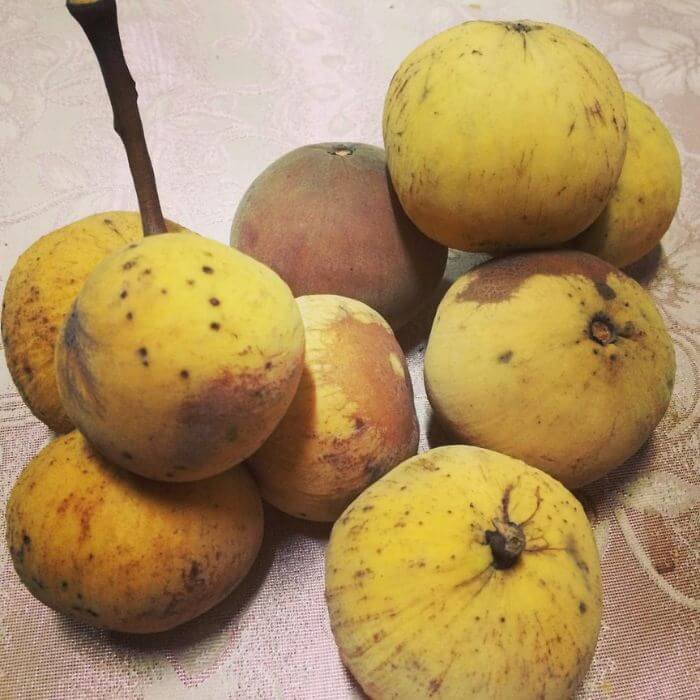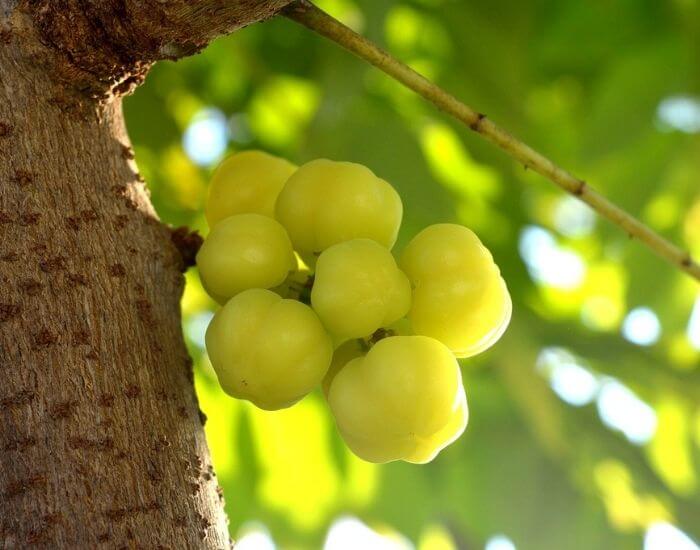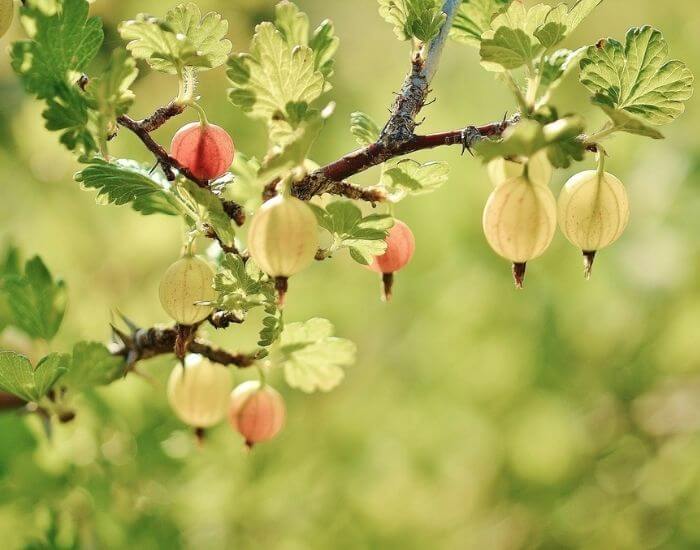Santol fruit, also known as cotton fruit , is a tropical fruit that is common in Southeast Asia and has been introduced to Australia.
It is widely popular in countries such as Thailand, Philippines, Indonesia and Malaysia due to its unique flavor. Santol has a tough outer skin with a soft white pulp inside that is sweet and sour in taste.
This article will delve deeper into the world of santol fruit, exploring its origin, nutritional value and more. We’ll also provide tips on how to enjoy this tropical delicacy at home through various recipes and serving suggestions.
Whether you’re already a fan of this brown fruit or curious about trying it for the first time, this article will serve as your ultimate guide to all things santol fruit.
What is santol fruit?
Santol fruit, also known as Sentul, is a fruit commonly found in Southeast Asia. It has a unique flavor that can be described as sweet and sour with a slightly acidic taste. The fruit is round and can be up to 2.7 inches in diameter, with a tough outer layer that needs to be peeled off before consumption.
The flesh of the santol fruit is divided into several segments, each containing one seed. These seeds are not edible and should be removed before eating the flesh.
Santol fruit can be eaten raw or cooked, but it is mostly used for making jams and jellies.
Cotton fruit color
When santol fruits are still young and unripe, they are usually green in color. As they mature and start to ripen, their skin turns yellowish-green with hints of brown.
When fully matured, the skin becomes thinner and starts to crack open revealing the white flesh inside which has a sweet-sour taste. At this stage, the santol fruit can be harvested for consumption or left on the tree longer to turn into bright red-orange colors.
How to tell if santol is ripe
To tell if santol fruit is ripe, here is what to look for.
- Firstly, check the color of the skin. A ripe santol fruit will have a golden yellow skin that feels slightly soft when pressed. If the skin is green, it means that the fruit is not yet fully matured.
- Secondly, give the fruit a light squeeze. A ripe santol fruit should yield slightly to pressure but still be firm to touch. If it feels too soft or mushy, it may be overripe and not good for consumption.
- Lastly, smell the stem end of the santol fruit. A sweet fragrance indicates that it’s fully ripe while an unpleasant odor suggests otherwise.
How to prepare Cotton fruit
To prepare santol, start by cutting off the top and bottom ends of the fruit and scoring its outer shell with shallow cuts.
Then use your fingers to peel away the skin and remove any remaining seeds or fibrous parts from inside.
Finally, slice into bite-sized pieces and enjoy! Keep in mind that santol can tarty on its own, so it’s often paired with sugar or salt for added flavor.
What country is Santol from?
It is believed to have originated from the Philippines and has been cultivated in various parts of the country since ancient times. The fruit tree grows up to 65 feet tall and produces large, round fruits with a tough outer skin.
Aside from the Philippines, santol trees are also found in other countries such as Indonesia, Thailand, Cambodia, Vietnam, Myanmar, Malaysia and Australia.
In these countries, the fruit is widely consumed either fresh or cooked in various dishes such as curries and stews. Santol fruits can also be canned or made into jams and syrups.
Santols are enjoyed for their sweet and sour taste with a slightly tangy flavor that resembles mangosteen.
Related Read: Learn about caja fruits
Nutritional facts
Santol fruit contains various essential nutrients such as vitamin C, calcium, iron, phosphorus, and potassium.
One serving of santol fruit (100 grams) provides 63% of the recommended daily intake of vitamin C.
When is santol in season

source:babyalma81
Santol season varies depending on the location but typically starts from May to July.
In the Philippines, santol trees start bearing fruits from June to October while in Thailand it usually starts from May until July.
During its peak season, santol fruits are abundant which makes them more affordable and accessible for consumers.
What does santol fruit taste like?
It has a unique taste that can be described as sweet and tart. The flesh of the fruit is soft, juicy, and fibrous, while the skin is thick and tough.
When you first bite into a santol fruit, you’ll notice its slightly tart flavor followed by notes of sweetness with an almost creamy texture.
As you continue to eat it, the sourness will become more pronounced but not overpowering. The seeds inside are also edible and have a nutty flavor similar to chestnuts.
Santol fruits are often used in desserts such as jams or jellies but can also be eaten fresh if ripe enough. It’s definitely an acquired taste, but many people who grew up eating this fruit consider it one of their favorites due to its unique flavor profile.
Ways to eat Sentul
One way to eat santol fruit is by simply peeling off the skin and biting into the juicy flesh. This method allows you to savor the natural sweetness of the fruit while also enjoying its tangy flavor. Another popular way to eat santol is by dipping it in salt or sugar, which helps enhance its taste.
If you prefer cooked fruits, then you can try making santol jam or preserve. To make santol jam, simply boil peeled and sliced santol with sugar until it forms a thick consistency. You can also use this jam as a spread on toast or crackers.
How to use in drinks
Santol fruit is a popular tropical fruit that is enjoyed in many Southeast Asian countries. It has a tart and slightly sweet taste, with a chewy texture and large seeds inside. While it can be eaten as is, there are also several ways to drink santol fruit.
One way to drink this fruit is by making a refreshing juice or smoothie. To make the juice, simply remove the flesh from the seeds, blend it with water and sugar to taste, and strain out any remaining pulp.
For a santol smoothie, add milk or yogurt to the blended mixture for a creamier consistency.
Another way to drink santol fruit is by fermenting it into wine or vinegar. Santol wine has gained popularity in Filipino cuisine as an accompaniment to traditional dishes like adobo and lechon.
Santol Wine Recipe
Ingredients:
-2 pounds fresh mangosteen fruit
– 1 gallon water
– 2 cups sugar
– 1 package wine yeast
Instructions:
1. Cut the santol fruit into pieces and place them in a large pot.
2. Pour the water over the fruit and bring to a boil.
3. Reduce heat and let simmer for 30 minutes.
4. Add sugar and stir until dissolved.
5. Let mixture cool to room temperature.
6. Once cooled, sprinkle the wine yeast over the top of the mixture and let sit for 10 minutes.
7. Pour mixture into a sterilized glass jar or jug with an airlock lid.
8. Store in a cool, dark place for 4-6 weeks, or until fermentation is complete.
9. Once done, strain liquid through a cheesecloth or fine mesh strainer before serving chilled or at room temperature.
How to store cotton fruit
It’s important to choose ripe sandorica fruits while buying them from the market. This will ensure that they are ready for consumption and will stay fresh for a few days at room temperature.
However, if you want to store the fruits for longer periods of time, refrigeration is recommended.
To store santol fruits in the refrigerator, wrap each fruit in paper towels or newspaper before placing them in an airtight container.
This helps absorb any excess moisture and prevent mold growth on the outer skin of the fruit. Stored this way, santols can last up to two weeks without losing their flavor or texture.
If you have more than you can eat within two weeks’ time frame, then consider freezing which can last up to three months when stored correctly.
Simply peel and remove seeds before cutting into pieces then place them into an air-tight freezer bag then seal off properly before putting into your freezer compartment at 0°F (-18°C) or below where they’ll keep their quality indefinitely!
Where to buy Santols
If you’re looking to buy sandorica fruit, your best bet would be local markets or grocery stores in Southeast Asian countries such as the Philippines, Thailand, Indonesia, and Malaysia.
Santol fruits are usually available during their peak season which falls between July to October. In some areas where santols are abundant, they can also be found sold by street vendors.
For those who do not live in Southeast Asia but still want to try this fruit out, there are online retailers that sell frozen or canned santol pulp.
However, take note that the taste and texture may differ from fresh ones due to preservation methods used for these products.
Is mangosteen and santol the same?
The santol has a tough brown peel with soft white flesh inside that surrounds large seeds. The taste of santol fruit can be described as sour or tart with a hint of sweetness.
On the other hand mangosteen, also from Southeast Asia, has a hard purple outer rind and soft white flesh inside which surrounds small seeds. Mangosteen is known for its sweet and tangy flavor profile, making it popular in desserts and juice drinks.
While both fruits are commonly found in Southeast Asia and have similar appearances when their outer shells are removed, they have distinct differences in taste and texture.
Santol has sour notes while mangosteen leans towards being sweet.
What fruits are similar to santol
One of the closest options is the mangosteen fruit. Mangosteen has a similar flesh texture and color as santol, with its sweet-tart taste and juicy flesh.
Another fruit that shares similarities with santol is the mamon chino. Mamon chino has a slightly sweeter taste than santol, but it also has an acidic kick to it that makes it quite refreshing. The texture is also similar to santol as it features soft, juicy flesh surrounding the seed.
sources
Hi There,
My name is Jenny. I’m the Chief Editor at Try Green Recipes and besides making yummy and healthy foods for my kids, grandkids, and friends. I’m new to the blogging world but I believe what I have to share is unique and will bring joy to your home. If you are adventurous and want try something tasty, let’s get started.

